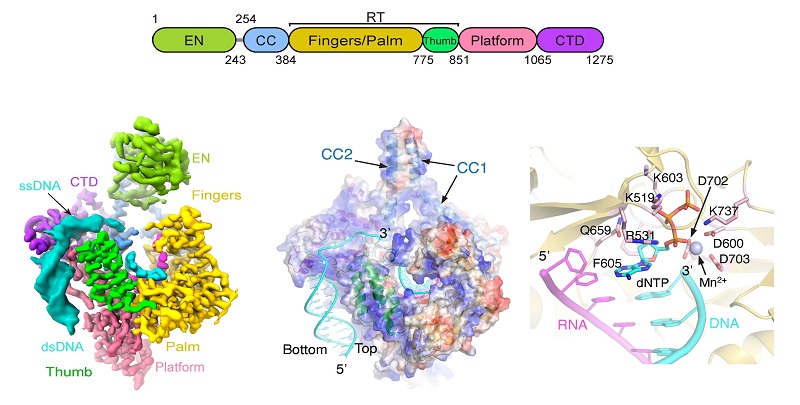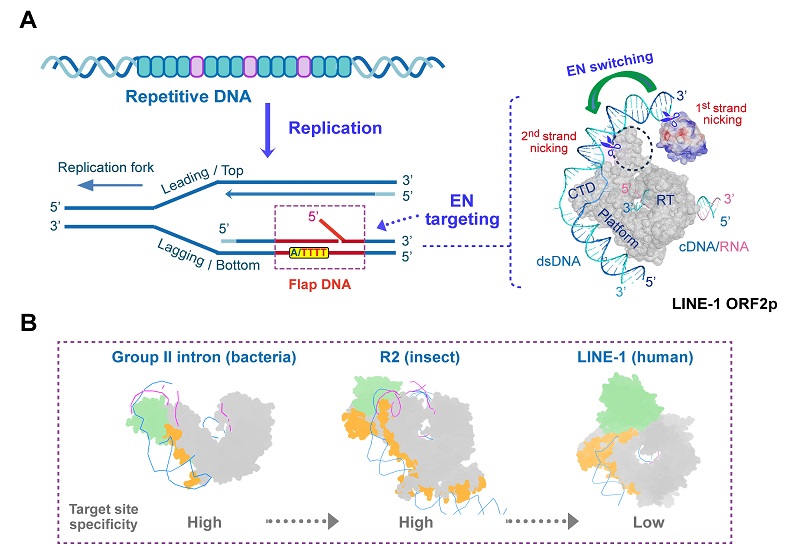Long Interspersed Nuclear Element-1 (LINE-1 or L1) is the only active, self-copying genetic element in the human genome-comprising about 17% of the genome. It is commonly called a "jumping gene" or "retrotransposon" because it can "retrotranspose" (move) from one genomic location to another.
Researchers from the Institute of Biophysics of the Chinese Academy of Sciences have now unveiled the molecular mechanisms that underlie L1's retrotransposition and integration into genomic DNA.
The study was published in Science on October 9.
L1 is the only autonomously active retrotransposon in the human genome and serves as the primary vehicle for the mobilization of most other retrotransposons. Its retrotransposition process is mediated by the reverse transcriptase ORF2p through a mechanism known as target-primed reverse transcription (TPRT). Until now, the manner in which ORF2p recognizes DNA targets and mediates integration had remained unclear.
Led by Profs. XU Ruiming, ZHU Bing, and XUE Yuanchao, the researchers purified an active ORF2p-endogenous nucleic acid complex and resolved its high-resolution three-dimensional structure using single-particle cryo-electron microscopy (cryo-EM). Structural analysis revealed that ORF2p binds genomic DNA through strong surface electrostatic interactions. It also showed that cDNA (complementary DNA) synthesis occurs at the reverse transcriptase (RT) active center through allosteric modulation of multiple amino acid residues.
Importantly, the researchers established the first efficient in vitro DNA cleavage system for ORF2p, demonstrating that it functions as a structure-dependent endonuclease. They discovered that ORF2p exhibits high catalytic activity toward specific forked DNA substrates, particularly flap structures characteristic of the lagging strand during DNA replication. Conformational changes in the endonuclease (EN) domain enable stepwise cleavage of double-stranded DNA. This finding provides a molecular basis for the coupling between L1 integration and the cellular replication cycle.
Cross-species structural comparisons with homologous proteins from bacteria and insects revealed both conserved and divergent features in retrotransposase evolution: While reverse transcription activity is highly conserved, the mechanisms for DNA recognition and cleavage have undergone significant diversification.
Taken together, this study elucidates the nucleic acid binding mode of ORF2p and the DNA structure-mediated mechanism governing its site-specific cleavage during L1 retrotransposition. ORF2p interacts primarily with the DNA backbone through electrostatic forces, rather than sequence-specific recognition, highlighting its unique physiological role.
This work fundamentally advances our understanding of the mechanism of L1 retrotransposition and provides a new theoretical framework for developing therapeutics targeting retrotransposon regulation.

Structure of the functional LINE-1 ORF2p retrotransposition complex (Image by XU Ruiming's group)

Molecular mechanism of DNA targeting and cleavage by LINE-1 reverse transcriptase. (A) LINE-1 specifically recognizes fork-like DNA structures formed during replication and achieves double-stranded DNA cleavage through conformational changes in the EN domain. (B) Structural comparison of reverse transcriptases from lower to higher organisms. (Image by XU Ruiming's group)






